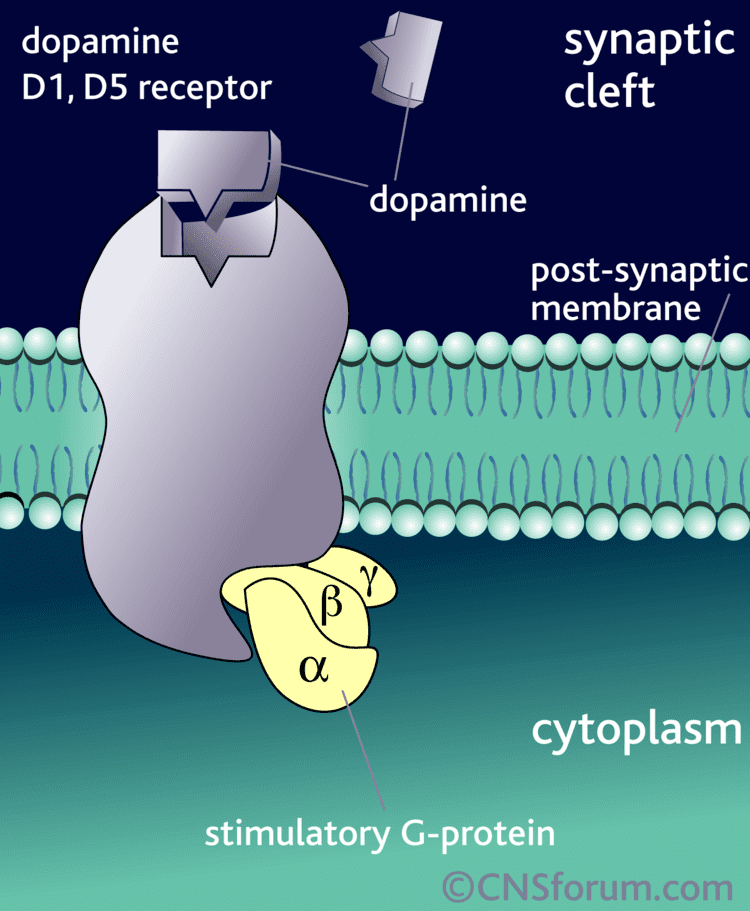Species Human Entrez 1812 | Human Mouse Ensembl ENSG00000184845 | |
 | ||
External IDs MGI: 99578 HomoloGene: 30992 GeneCards: DRD1 | ||
Gene music using protein sequence of drd1 dopamine receptor d1
Dopamine receptor D1, also known as DRD1, is a protein that in humans is encoded by the DRD1 gene.
Contents
- Gene music using protein sequence of drd1 dopamine receptor d1
- Function
- Production
- Ligands
- Agonists
- List of D1 receptor agonists
- Antagonists
- List of D1 receptor antagonists
- Proteinprotein interactions
- Receptor oligomers
- References
Function

This gene encodes the D1 subtype of the dopamine receptor. The D1 subtype is the most abundant dopamine receptor in the central nervous system. This G-protein coupled receptor is Gs/a coupled and indirectly activates cyclic AMP-dependent protein kinase; stimulating the neuron. nuD1 receptors regulate neuronal growth and development, mediate some behavioral responses, and modulate dopamine receptor D2-mediated events. Alternative transcription initiation sites result in two transcript variants of this gene. D1-D2 dopamine receptor heteromer formation is observed.
Production

The DRD1 gene expresses primarily in the caudate putamen in humans, and in the caudate putamen, the nucleus accumbens and the olfactory tubercle in mouse. Gene expression patterns from the Allen Brain Atlases in mouse and human can be found here.
Ligands
There are a number of ligands selective for the D1 receptors. To date, most of the known ligands are based on dihydrexidine or the prototypical benzazepine partial agonist SKF-38393 (one derivative being the prototypical antagonist SCH-23390). D1 receptor has a high degree of structural homologine to another dopamine receptor, D5, and they both bind similar drugs. As a result, none of the known ligands is selective for the D1 vs. the D5 receptor, but the benzazepines generally are more selective for the D1 and D5 receptors versus the D2-like family. Some of the benzazepines have high intrinsic activity whereas others do not.
Agonists

Several D1 receptor agonists are used clinically. These include apomorphine, pergolide, rotigotine, and terguride. All of these drugs are preferentially D2-like receptor agonists. Fenoldopam is a selective D1 receptor partial agonist that does not cross the blood-brain-barrier and is used intravenously in the treatment of hypertension. Dihydrexidine and adrogolide (ABT-431) (a prodrug of A-86929 with improved bioavailability) are the only selective, centrally active D1-like receptor agonists that have been studied clinically in humans. They produced dose-limiting profound hypotension and dyskinesias, respectively, and were not further developed for clinical use.
List of D1 receptor agonists
Antagonists
Many typical and atypical antipsychotics are D1 receptor antagonists in addition to D2 receptor antagonists. No other D1 receptor antagonists have been approved for clinical use. Ecopipam is a selective D1-like receptor antagonist that has been studied clinically in humans in the treatment of a variety of conditions, including schizophrenia, cocaine abuse, obesity, pathological gambling, and Tourette's syndrome, with efficacy in some of these conditions seen. The drug produced mild-to-moderate, reversible depression and anxiety in clinical studies however and has yet to complete development for any indication.
List of D1 receptor antagonists
Protein–protein interactions
Dopamine receptor D1 has been shown to interact with:
Receptor oligomers
The D1 receptor forms heteromers with the following receptors: dopamine D2, D3, histamine H3, μ opioid.
